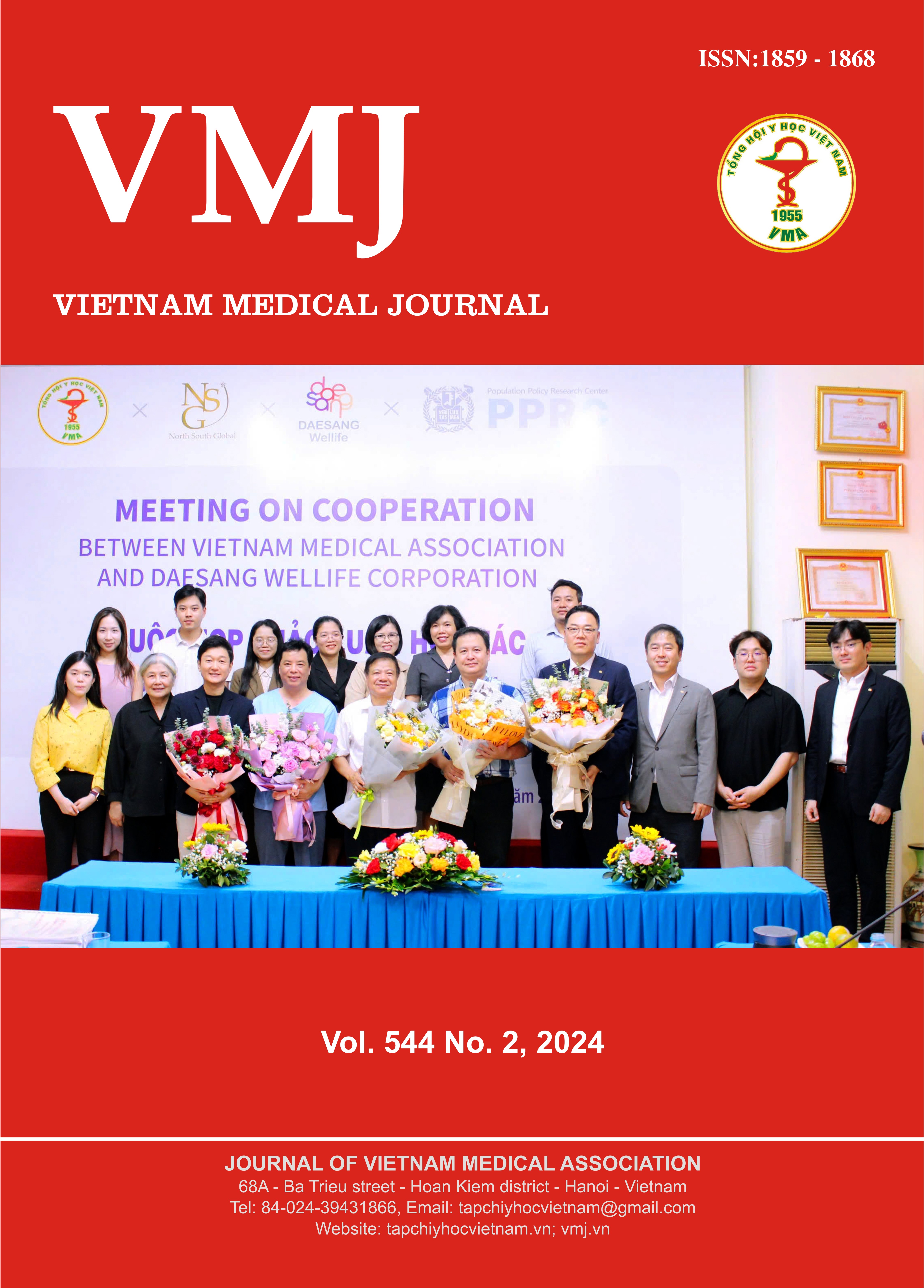PRIMARY ANTIBIOTIC RESISTANCE OF HELICOBACTER PYLORI IN PEPTIC ULCER DISEASE PATIENTS
Main Article Content
Abstract
Background: Antibiotic resistance is the main cause of failure in Helicobacter pylori (H. pylori) eradication. Updating the antibiotic resistance situation of H. pylori in each region is important for recommending appropriate treatment regimens for the population and optimizing the effectiveness of H. pylori eradication treatment for each region and country. Objective: To determine the rate of primary antibiotic resistance of H. pylori strains to Amoxicillin (AMX), Clarithromycin (CLA), Levofloxacin (LEV), Metronidazole (MET), and Tetracycline (TET). Method: A cross-sectional descriptive study was performed on 216 patients with peptic ulcer disease who underwent endoscopy and antibiotic culture by Epsilometer test (E-test) at the American International Hospital from October 2019 to September 2022. Results: The rate of primary resistance to Clarithromycin was the highest at 96.30%, while the rates of resistance to Levofloxacin, Metronidazole, and Amoxicillin were 58.8%, 8.80%, and 2.78%, respectively. In the study, there were no cases of primary antibiotic resistance to Tetracycline, with a resistance rate of 0%. There was no statistically significant difference in the rate of resistance to each antibiotic between the male and female groups (p > 0.05). The rate of dual resistance to two antibiotics was very high, with 161/216 cases (74.54%), and the highest rate of resistance was to CLA + LEV with 124 cases (57.41%). The rates of H. pylori strains resistant to CLA + MET, MET + LEV, CLA + AMX, AMX + LEV, and AMX + MET were 7.41%, 3.7%, 2.78%, 1.39%, and 0.46%, respectively. There were 11 cases of H. pylori strains resistant to three types of antibiotics, a rate of 5.09%, and there were no cases resistant to four or more antibiotics. Only 1.39% remained sensitive to all five antibiotics in eradication regimens. Conclusion: The very high rate of resistance to Clarithromycin indicates that the standard triple regimen is no longer effective and should not be used in clinical practice. The regimen with Levofloxacin should be combined with Bismuth to enhance treatment effectiveness. The rates of resistance to Amoxicillin, Tetracycline, and Metronidazole were low, so a Bismuth quadruple or a combination of these three drugs may be very effective in eradicating H. pylori.
Article Details
Keywords
Primary antibiotic resistance, Helicobacter pylori, H.pylori, peptic ulcer disease
References
2. Iarc Working Group on the Evaluation of Carcinogenic Risks to Humans. Biological agents. Volume 100 B. A review of human carcinogens. IARC Monogr Eval Carcinog Risks Hum. 2012;100(Pt B):1-441.
3. Savoldi A, Carrara E, Graham DY, et al. Prevalence of Antibiotic Resistance in Helicobacter pylori: A Systematic Review and Meta-analysis in World Health Organization Regions. Gastroenterology. Nov 2018;155(5):1372-1382.e17. doi:10.1053/j.gastro.2018.07.007
4. Khien VV, Thang DM, Hai TM, et al. Management of Antibiotic-Resistant Helicobacter pylori Infection: Perspectives from Vietnam. Gut and liver. Sep 15 2019;13(5):483-497. doi:10.5009/gnl18137
5. Tang X, Wang Z, Shen Y, et al. Antibiotic resistance patterns of Helicobacter pylori strains isolated from the Tibet Autonomous Region, China. BMC microbiology. 2022/08/13 2022;22(1):196. doi:10.1186/s12866-022-02613-y
6. Ferro A, Morais S, Pelucchi C, et al. Sex differences in the prevalence of Helicobacter pylori infection: an individual participant data pooled analysis (StoP Project). European journal of gastroenterology & hepatology. May 2019;31(5):593-598. doi:10.1097/meg.0000000000001389
7. Baradaran A, Dehghanbanadaki H, Naderpour S, et al. The association between Helicobacter pylori and obesity: a systematic review and meta-analysis of case–control studies. Clinical Diabetes and Endocrinology. 2021/07/10 2021;7(1):15. doi:10.1186/s40842-021-00131-w
8. Nguyen LT, Nguyen VB, Tran TV, et al. Efficacy of Helicobacter pylori Eradication Based on Rabeprazole-Bismuth-Tetracycline-Tinidazole Regimen in Vietnamese Patients with Duodenal Ulcers. Gastroenterol Insights 2022;13(4):365-376. doi:https://doi.org/10.3390/gastroent13040036
9. Binh TT, Shiota S, Nguyen LT, et al. The incidence of primary antibiotic resistance of Helicobacter pylori in Vietnam. Journal of clinical gastroenterology. Mar 2013;47(3):233-8. doi:10.1097/MCG.0b013e3182676e2b
10. Phan Trung Nam, Trần Văn Huy, Trần Thị Như Hoa. Tình hình đề kháng kháng sinh của Helicobacter pylori tại khu vực miền Trung hai năm 2012-2013 bằng kỹ thuật E-test. Tạp chí Khoa học tiêu hoá Việt Nam. 2013;VIII(33):2122-2132. .
11. Quek C, Pham ST, Tran KT, et al. Antimicrobial susceptibility and clarithromycin resistance patterns of Helicobacter pylori clinical isolates in Vietnam. F1000Res. 2016;5:671-671. doi:10.12688/f1000research.8239.1
12. Đặng Ngọc Quý Huệ. Nghiên cứu tỷ lệ kháng clarithromycin, levofloxacin của helicobacter pylori bằng epsilometer và hiệu quả của phác đồ EBMT ở bệnh nhân viêm dạ dày mạn. luận án tiến sĩ y học. 2018;
13. Shiota S, Reddy R, Alsarraj A, et al. Antibiotic Resistance of Helicobacter pylori Among Male United States Veterans. Clinical gastroenterology and hepatology : the official clinical practice journal of the American Gastroenterological Association. Sep 2015;13(9):1616-24. doi:10.1016/j.cgh.2015.02.005
14. Kuo YT, Liou JM, El-Omar EM, et al. Primary antibiotic resistance in Helicobacter pylori in the Asia-Pacific region: a systematic review and meta-analysis. The lancet Gastroenterology & hepatology. Oct 2017;2(10):707-715. doi:10.1016/s2468-1253(17)30219-4
15. Bachir M, Allem R, Tifrit A, et al. Primary antibiotic resistance and its relationship with cagA and vacA genes in Helicobacter pylori isolates from Algerian patients. 10.1016/j.bjm.2017.11.003. Brazilian Journal of Microbiology. 2018;49(3):544-551. doi:10.1016/j.bjm.2017.11.003
16. Wang D, Guo Q, Yuan Y, et al. The antibiotic resistance of Helicobacter pylori to five antibiotics and influencing factors in an area of China with a high risk of gastric cancer. BMC microbiology. 2019/07/04 2019;19(1):152. doi:10.1186/s12866-019-1517-4
17. Palmitessa V, Monno R, Panarese A, et al. Evaluation of Antibiotic Resistance of Helicobacter pylori Strains Isolated in Bari, Southern Italy, in 2017-2018 by Phenotypic and Genotyping Methods. Microbial drug resistance (Larchmont, NY). Aug 2020;26(8):909-917. doi:10.1089/mdr.2019.0262
18. Malfertheiner P, Megraud F, Rokkas T, et al. Management of Helicobacter pylori infection: the Maastricht VI/Florence consensus report. Gut. Aug 8 2022;doi:10.1136/gutjnl-2022-327745
19. Yahav J, Samra Z, Niv Y, et al. Susceptibility-guided vs. empiric retreatment of Helicobacter pylori infection after treatment failure. Digestive diseases and sciences. Dec 2006;51(12):2316-21. doi:10.1007/s10620-006-9302-2
20. Huang X, Liu Y, Lin Z, et al. Minimum inhibitory concentrations of commonly used antibiotics against Helicobacter Pylori: A multicenter study in South China. PLOS ONE. 2021;16(9):e0256225. doi:10.1371/journal.pone.0256225


